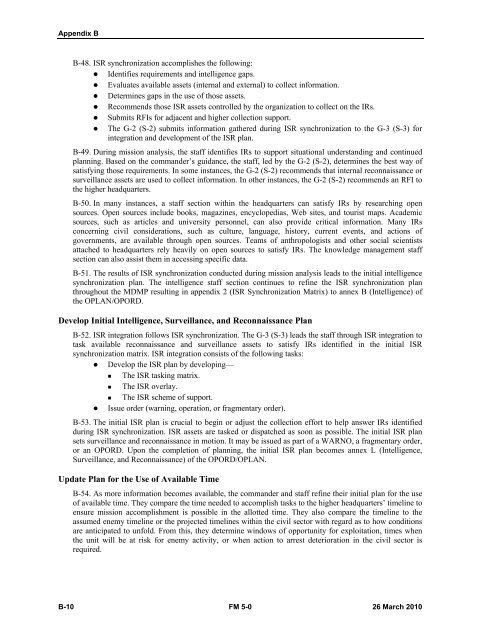FM 5-0, The Operations Process - Federation of American Scientists
FM 5-0, The Operations Process - Federation of American Scientists
FM 5-0, The Operations Process - Federation of American Scientists
You also want an ePaper? Increase the reach of your titles
YUMPU automatically turns print PDFs into web optimized ePapers that Google loves.
Appendix B<br />
B-48. ISR synchronization accomplishes the following:<br />
• Identifies requirements and intelligence gaps.<br />
• Evaluates available assets (internal and external) to collect information.<br />
• Determines gaps in the use <strong>of</strong> those assets.<br />
• Recommends those ISR assets controlled by the organization to collect on the IRs.<br />
• Submits RFIs for adjacent and higher collection support.<br />
• <strong>The</strong> G-2 (S-2) submits information gathered during ISR synchronization to the G-3 (S-3) for<br />
integration and development <strong>of</strong> the ISR plan.<br />
B-49. During mission analysis, the staff identifies IRs to support situational understanding and continued<br />
planning. Based on the commander’s guidance, the staff, led by the G-2 (S-2), determines the best way <strong>of</strong><br />
satisfying those requirements. In some instances, the G-2 (S-2) recommends that internal reconnaissance or<br />
surveillance assets are used to collect information. In other instances, the G-2 (S-2) recommends an RFI to<br />
the higher headquarters.<br />
B-50. In many instances, a staff section within the headquarters can satisfy IRs by researching open<br />
sources. Open sources include books, magazines, encyclopedias, Web sites, and tourist maps. Academic<br />
sources, such as articles and university personnel, can also provide critical information. Many IRs<br />
concerning civil considerations, such as culture, language, history, current events, and actions <strong>of</strong><br />
governments, are available through open sources. Teams <strong>of</strong> anthropologists and other social scientists<br />
attached to headquarters rely heavily on open sources to satisfy IRs. <strong>The</strong> knowledge management staff<br />
section can also assist them in accessing specific data.<br />
B-51. <strong>The</strong> results <strong>of</strong> ISR synchronization conducted during mission analysis leads to the initial intelligence<br />
synchronization plan. <strong>The</strong> intelligence staff section continues to refine the ISR synchronization plan<br />
throughout the MDMP resulting in appendix 2 (ISR Synchronization Matrix) to annex B (Intelligence) <strong>of</strong><br />
the OPLAN/OPORD.<br />
Develop Initial Intelligence, Surveillance, and Reconnaissance Plan<br />
B-52. ISR integration follows ISR synchronization. <strong>The</strong> G-3 (S-3) leads the staff through ISR integration to<br />
task available reconnaissance and surveillance assets to satisfy IRs identified in the initial ISR<br />
synchronization matrix. ISR integration consists <strong>of</strong> the following tasks:<br />
• Develop the ISR plan by developing—<br />
• <strong>The</strong> ISR tasking matrix.<br />
• <strong>The</strong> ISR overlay.<br />
• <strong>The</strong> ISR scheme <strong>of</strong> support.<br />
• Issue order (warning, operation, or fragmentary order).<br />
B-53. <strong>The</strong> initial ISR plan is crucial to begin or adjust the collection effort to help answer IRs identified<br />
during ISR synchronization. ISR assets are tasked or dispatched as soon as possible. <strong>The</strong> initial ISR plan<br />
sets surveillance and reconnaissance in motion. It may be issued as part <strong>of</strong> a WARNO, a fragmentary order,<br />
or an OPORD. Upon the completion <strong>of</strong> planning, the initial ISR plan becomes annex L (Intelligence,<br />
Surveillance, and Reconnaissance) <strong>of</strong> the OPORD/OPLAN.<br />
Update Plan for the Use <strong>of</strong> Available Time<br />
B-54. As more information becomes available, the commander and staff refine their initial plan for the use<br />
<strong>of</strong> available time. <strong>The</strong>y compare the time needed to accomplish tasks to the higher headquarters’ timeline to<br />
ensure mission accomplishment is possible in the allotted time. <strong>The</strong>y also compare the timeline to the<br />
assumed enemy timeline or the projected timelines within the civil sector with regard as to how conditions<br />
are anticipated to unfold. From this, they determine windows <strong>of</strong> opportunity for exploitation, times when<br />
the unit will be at risk for enemy activity, or when action to arrest deterioration in the civil sector is<br />
required.<br />
B-10 <strong>FM</strong> 5-0 26 March 2010















